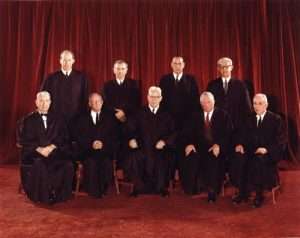The Volokh Conspiracy
Mostly law professors | Sometimes contrarian | Often libertarian | Always independent
Today in Supreme Court History: October 31, 1963
10/31/1963: Cleveland Police Detective patted down, and arrested John W. Terry.

Editor's Note: We invite comments and request that they be civil and on-topic. We do not moderate or assume any responsibility for comments, which are owned by the readers who post them. Comments do not represent the views of Reason.com or Reason Foundation. We reserve the right to delete any comment for any reason at any time. Comments may only be edited within 5 minutes of posting. Report abuses.
Please to post comments




General Atomic Co. v. Felter, 434 U.S. 12 (decided October 31, 1977): state court can’t enjoin litigants from filing actions in federal court
Kane v. Garcia Espitia, 546 U.S. 9 (decided October 31, 2005): does the right to self-representation require a pro se defendant to have access to the prison law library? Because the Supreme Court had not ruled on the issue, the Circuit Court erred in holding that the “clearly established federal law” requirement for habeas relief applied (but the Court here refuses to rule on the issue! — and remands for “further proceedings consistent with this opinion” — ???)
Louisiana v. Mississippi, 516 U.S. 22 (decided October 31, 1995): in this original jurisdiction case, Court holds that Stack Island is still in Mississippi even though main channel of the Mississippi River now runs on the Mississippi side of it and accretion plus erosion has shifted the island toward Louisiana (applies the “island exception to the rule of thalweg” which serves to prevent change of jurisdiction over the island) (a thalweg is a zigzag line tracing the deepest points of a river bed as one goes downstream; it is often used to define a border) (Stack Island was, according to Wikipedia, “a rendezvous for horse thieves, counterfeiters, robbers and murders” until the New Madrid earthquakes of 1811 – 1812 reduced it to a sand bar)
RE: Kane v. Garcia Espitia
". . . but the Court here refuses to rule on the issue!"
But the Court did rule in their per curiam decision, "The judgment below is reversed, and the case is remanded for further proceedings consistent with this opinion."
https://supreme.justia.com/cases/federal/us/546/9/
That’s my point. The Court declares that it’s not making a ruling and the demands for further proceedings consistent with that (lack of) ruling.
So why does it matter to anyone whether a sand bar is in MS or LA?
I was wondering that too. Google Maps shows that it's pretty big for a sand bar (about four miles long) with trees on it but apparently no buildings. I used to live on the lower Mississippi and little islands like that are pretty common. No one lives there except people like fugitives who are there only temporarily.
The opinion says that Louisiana argued that the island disappeared in 1883 and in 1949, which they claimed meant that the "present" island was Louisiana's. The suit was pressed by landowners for whom the jurisdiction of the island was an issue -- maybe because it's used in a metes and bounds to define a boundary.